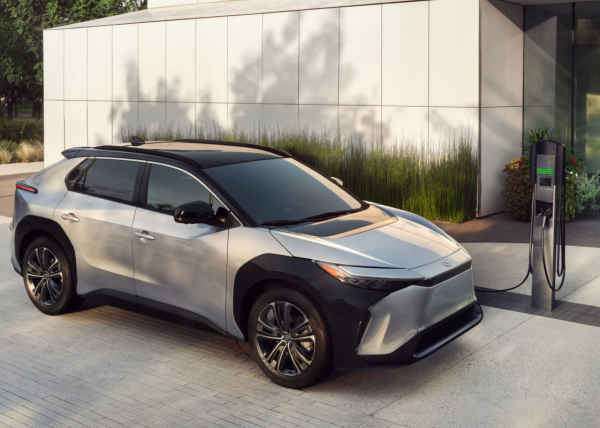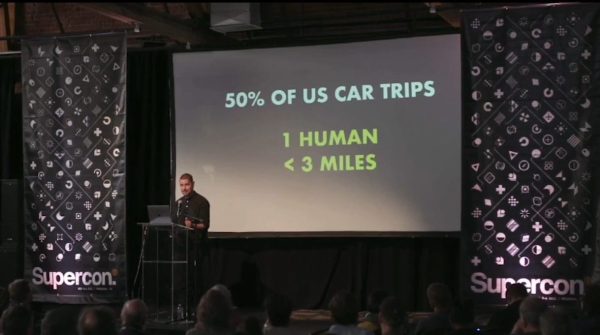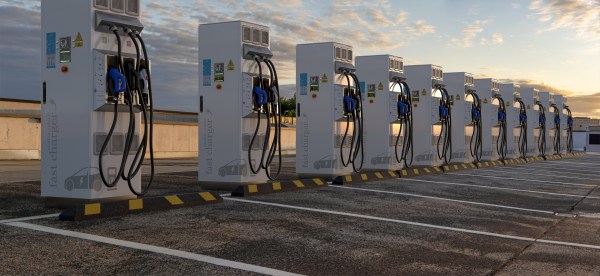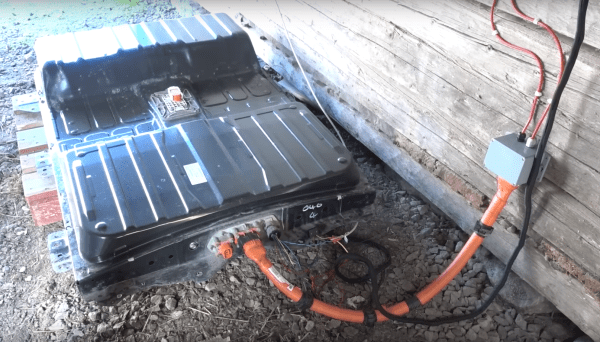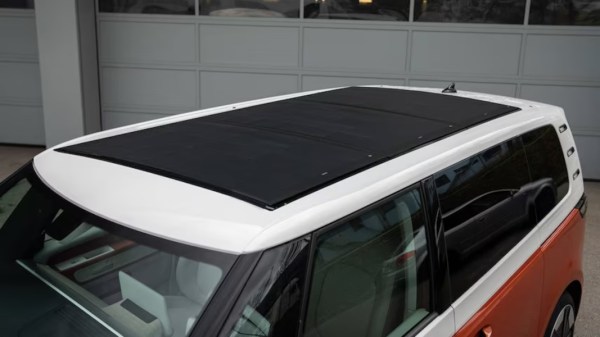Toyota is going through a bit of a Kodak moment right now, being that like the film giant they absolutely blundered the adoption of a revolutionary technology. In Kodak’s case it was the adoption of the digital camera which they nearly completely ignored; Toyota is now becoming similarly infamous for refusing to take part in the electric car boom, instead placing all of their faith in hybrid drivetrains and hydrogen fuel cell technologies. Whether or not Toyota can wake up in time to avoid a complete Kodak-style collapse remains to be seen, but they have been making some amazing claims about battery technology that is at least raising some eyebrows. Continue reading “Toyota Makes Grand Promises On Battery Tech”
electric vehicle110 Articles
Supercon 2022: Bradley Gawthrop Wants You To Join The PEV Revolution
During the 20th Century, much of the western world decided that motor vehicles were the only desirable form of transportation. We built our cities to accommodate cars through parking, stop lights, and any number of other infrastructure investments so that you could go get milk and bread in style. In the US, 50% of automobile trips are less than three miles and have only one occupant. [Bradley Gawthrop] asked if there might be a more efficient way to do all this? Enter the Personal Electric Vehicle (PEV).
What Are PEVs?

PEVs are a nascent part of the transportation mix that fall under the wider umbrella of “micromobility,” including scooters, bikes, skateboards, and the like. The key differentiator here is that they are at least partially electrically-driven. [Gawthrop] walks us through several of the different types during his Supercon 2022 talk, but since they are all small, electric powered devices for transporting one or two people, they can trace their lineage back to the infamous Segway Human Transporter.
Using an electric motor or two connected to a controller and batteries, the overall system complexity for any of these devices is quite low and ripe for the hacking. Given the right tools and safety precautions, anyone should be able to crack a PEV open and repair or tinker with it. As with many things in life, the real story is more complicated.
As [Gawthrop] notes, many a hacker has said, “I wish I’d been able to be involved in X before…” where X equals some technology like home automation and it’s before it got creepy or dystopian in some manner. He exhorts us that the time to be in on the ground floor with PEVs is now. Continue reading “Supercon 2022: Bradley Gawthrop Wants You To Join The PEV Revolution”
An Unexpected Upset In EV Charging Standards
Last November, Tesla open-sourced parts of its charging infrastructure, not-so-humbly unveiling it as the North American Charging Standard (NACS). It’s finally taking off with a number of manufacturers signing on.
Companies launching “standards” based on their previously proprietary technology in opposition to an established alternative usually leads to standards proliferation. However, with recent announcements from Ford, GM, and Rivian that they would begin supporting NACS in their vehicles, it seems a new dominant standard is supplanting CCS (and the all-but-dead CHAdeMO) in North America.
As Tesla already has the most extensive charging network on the continent and has begun opening it up for other EVs, it makes sense that other marques would want to support NACS, if nothing else to satiate customer demand for a dead-simple charging experience. Dongles are annoying enough for plugging in an external monitor. Having to mess with one while handling high-power electrical connections is less than ideal, to say the least.
If you want to add NACS to your own EV project, the standard is here. We’ve discussed some of the different standards before as well as work toward wirelessly charging EVs (besides the inductive charger on the EV1). It certainly seems like the time to get in on the ground floor of an EV charging empire with an army of Charglas.
Vehicle-to-Grid Made Easy
As electric cars continue to see increased adoption, one associated technology that was touted long ago that still hasn’t seen widespread adoption is vehicle-to-grid or vehicle-to-home. Since most cars are parked most of the time, this would allow the cars to perform load-levelling for the grid or even act as emergency generators on an individual basis when needed. While this hasn’t panned out for a variety of reasons, it is still possible to use an EV battery for use off-grid or as part of a grid tie solar system, and now you can do it without needing to disassemble the battery packs at all.
Normally when attempting to use a scrapped EV battery for another use, the cells would be removed from the OEM pack and reorganized to a specific voltage. This build, however, eliminates the need to modify the packs at all. A LilyGO ESP32 is used to convert the CAN bus messages from the battery pack to the Modbus communications protocol used by the inverters, in this case a Fronius Gen24, so the inverter and battery can coordinate energy delivery from one to the other automatically. With the hard part out of the way, the only other requirements are to connect a high voltage DC cable from the battery pack to the inverter.
[Dala], the creator of this project, has taken other steps to ensure safety as well that we’d recommend anyone attempting to recreate this build pays close attention to, as these battery packs contain an extremely large amount of energy. The system itself supports battery packs from Nissan Leafs as well as the Tesla Model 3, which can usually be found for comparably low prices. Building battery energy storage systems to make up for the lack of commercially-available vehicle-to-home systems isn’t the only use for an old EV battery, though. For example, it’s possible to use Leaf batteries to triple the range of other EVs like [Muxsan] did with this Nissan van.
Electric Volkswagen Adds Rooftop Solar
Volkswagen has continually teased the release of a new Microbus in the same way that Duke Nukem Forever strung us all along in the 00s, but unlike the fated video game it seems as though Volkswagen is finally building a hip new van rather than continually teasing its release year after year. With the clunky name of I.D. Buzz, European drivers can expect to see them later this year while those in the North American market will have to wait until 2024. That release will have a camper-equipped option though, but you may also want to equip yours with some solar panels as well.
The German tuning shop ABT is behind this design, which adds 600 watts of solar fixed to the top of the van. The solar roof will generate electricity largely to power the van’s auxiliary systems and is being aimed at those who are looking to outfit this van as a camper and need something to power things like refrigerators, interior lighting, and various electronics while on extended stays. There is also some mention of a 1000 watt option but with the limited space available on the roof may involve a side panel of some sort.
ABT is also noting that this system can be used to extend the driving range and, while technically true, don’t expect to be driving an I.D. Buzz on entirely solar power unless you’re willing to let it sit to charge the battery for days at a time. Like other solar installations on vehicles we’ve seen from various ingenious builders, the lack of real estate available on passenger vehicles limits their use largely to auxiliary electrical loads, but it can be possible to drive a vehicle on solar energy alone with the right design.
Hackaday Links: January 22, 2023
The media got their collective knickers in a twist this week with the news that Wyoming is banning the sale of electric vehicles in the state. Headlines like that certainly raise eyebrows, which is the intention, of course, but even a quick glance at the proposed legislation might have revealed that the “ban” was nothing more than a non-binding resolution, making this little more than a political stunt. The bill, which would only “encourage” the phase-out of EV sales in the state by 2035, is essentially meaningless, especially since it died in committee before ever coming close to a vote. But it does present a somewhat lengthy list of the authors’ beefs with EVs, which mainly focus on the importance of the fossil fuel industry in Wyoming. It’s all pretty boneheaded, but then again, outright bans on ICE vehicle sales by some arbitrary and unrealistically soon deadline don’t seem too smart either. Couldn’t people just decide what car works best for them?
Speaking of which, a man in neighboring Colorado might have some buyer’s regret when he learned that it would take five days to fully charge his brand-new electric Hummer at home. Granted, he bought the biggest battery pack possible — 250 kWh — and is using a standard 120-volt wall outlet and the stock Hummer charging dongle, which adds one mile (1.6 km) to the vehicle’s range every hour. The owner doesn’t actually seem all that surprised by the results, nor does he seem particularly upset by it; he appears to know enough about the realities of EVs to recognize the need for a Level 2 charger. That entails extra expense, of course, both to procure the charger and to run the 240-volt circuit needed to power it, not to mention paying for the electricity. It’s a problem that will only get worse as more chargers are added to our creaky grid; we’re not sure what the solution is, but we’re pretty sure it’ll be found closer to the engineering end of the spectrum than the political end.
Hackaday Links: December 25, 2022
Looks like it’s lights out on Mars for the InSight lander. The solar-powered lander’s last selfie, sent back in April, showed a thick layer of dust covering everything, including the large circular solar panels needed to power the craft. At the time, NASA warned that InSight would probably give up the ghost sometime before the end of the year, and it looks like InSight is sticking to that schedule. InSight sent back what might be its last picture recently, showing the SEIS seismic package deployed on the regolith alongside the failed HP3 “mole” experiment, which failed to burrow into the soil as planned. But one bad experiment does not a failed mission make — it was wildly successful at most everything it was sent there to do, including documenting the largest marsquake ever recorded. As it usually does, NASA has anthropomorphized InSight with bittersweet sentiments like “Don’t cry, I had a good life,” and we’re not quite sure how we feel about that. On the one hand, it kind of trivializes the engineering and scientific accomplishments of the mission, but then again, it seems to engage the public, so in the final rinse, it’s probably mostly harmless.

